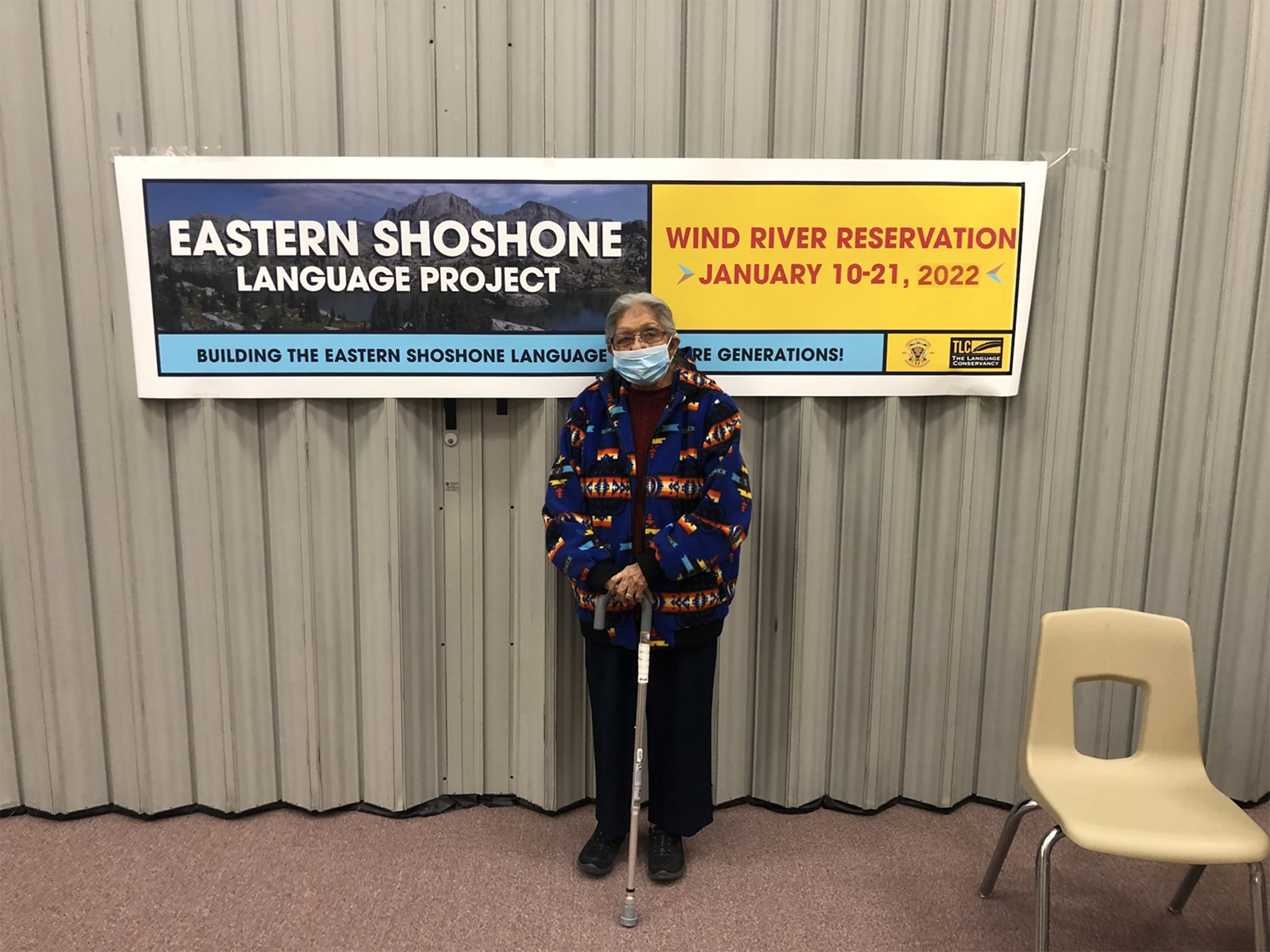“Just keep saying it, we will understand”: Elders compile Shoshone dictionary
Taylar Stagner | Wyoming Public Media | January 21, 2022

Ula Tyler (Shoshone) stands in front of the events banner.
Shoshone Elder Ula Tyler has been a participant for the last two weeks in the tribe’s efforts to create a dictionary with all six different clan dialects. Tyler was a Shoshone Language teacher on the Wind River Reservation for decades and has extensive knowledge of the language. She said some of her earliest memories are learning Shoshone with her mother.
From her years as a teacher, she would encounter students who were shy or were scared of messing up when trying to speak Shoshone, and she would try and encourage them.
“Keep saying it. You’ll learn it. You don’t have to be ashamed of it, it’s our language. We will understand what you are trying to say,” she said.
During the run of the project, Tyler was responsible for recording around 200 words in a single day.
The process is called Rapid Word Collection. There are group stations, typically two to three elders per group. Elders are assigned topics that range from as big as the universe or what to call different types of animals. And they think and talk with other elders about what words they know.
Robyn Rofkar is with the Shoshone cultural center in Fort Washakie. She applied to receive grant funding to put on the two-week-long event.
“And it’s sad to say, but where, you know, every year, we lose more and more fluent speakers, which is like losing a whole Encyclopedia of knowledge. So time is of the essence. It always has been,” Rofkar said.
There are about 200 fluent Shoshone speakers in the forty-five hundred member tribe and most of them are over the age of sixty. And since every Indigenous community was hit hard by the pandemic, the Shoshone have lost several very valuable speakers.
The reason the language is disappearing was that many were discouraged from speaking their native languages due to assimilation tactics like in Indian Boarding Schools, and it wasn’t until 1978 when the Native American Religious Freedom Act was passed that protected traditional aspects of Indigenous culture including traditional language.
However, generations of Indigenous people have lost contact with their language.
Rofkar said now there is a growing number of younger Shoshone people who want to learn more, but may not have access to the language in a few years. The local schools have limited time for Shoshone Language Classes.
“We need to do more to help the younger generation be able to learn it,” Rofkar said.
She said that once the dictionary is done, the cultural center wants to develop a phone app to help tribal members learn the language.
This issue has been worked on before but previous recordings seem to have disappeared. Their goal is to not let that happen again.
“[The] Eastern Shoshone tribe is the actual grantee of the grant and everything we do will be here, will be owned by the Eastern Shoshone tribe,” she said.
The Language Conservancy, the non-profit helping put together the dictionary, does not own or copyright any of the work being done during the project, so future projects like creating an app will be completely under the Eastern Shoshone control.
William Meya is the director of The Language Conservancy and said that their organization has worked with over 50 endangered languages internationally, and said now is the time to collect words for the younger generation.
“So, there’s not a lot of time left for Shoshone and we want to make sure that as much of the language is available for those young people that decide to learn it,” Meya said.
Meya also said that puts the Shoshone language in a unique position because of the advanced age of many of the elders on the project, and Meya says that in the next five to 10 years many won’t be available anymore.
“I was very surprised at the age of the speakers. Of course, they are excellent speakers and have a fantastic knowledge of their language, which is incredible, and a privilege to be a part of working with speakers that are 98 years old 91 years old, many in their late 80s,” he said.
The workshop collected around six thousand words for the dictionary and accompanying app that should be released in the next year.

